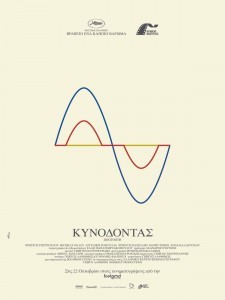LOSING CANINE TEETH: IDEAS SPURRED BY A MODERN GREEK FILM THAT IS NOT ABOUT MODERN GREECE
A DISTANCE FELT
I have a friend who I like spending time with but rarely end up seeing. The friend is a good person whose time means a lot, especially when it is shared with me. We call each other difficult, but what that means is that we like to hang out when we really want to, and refuse to negotiate our visceral wants for the other. It is a circumstantial friendship, despite its organicness. A major issue that arises frequently and poses Herculean efforts on both of our ends is that the friend lives in Brooklyn. [1] Despite the physical distance, it was the friend’s turn to come to me, because last time I went to Brooklyn, and I walked the Williamsburg bridge back and forth without ever seeing the friend, because the friend was asleep and never woke up and stood me up, and for that reason the friend would have to come to me this time and this was a non-negotiable term in an unwritten legal contract.
We decided to go to an East Village staple called “Sidewalk,” which is on Avenue A, and my friend grimaced a lot with my decision, because “how 90s grunge.” What the friend was going to witness would be a surprise, because this space was renovated ala gentrification in 2011 and there were no grimey aspects of my tall burger the very attractive (in a 90s way) waitress served me as she spoke in the familiar raspy voice that exuded bits of smoke here and there. [2]
What is interesting about where we chose to sit–which of course was the eastern side that functions as the smoking section of the outdoor seating area–is that it is located exactly near a gay bar called “Eastern Bloc,” which some people say belongs to Anderson Cooper’s boyfriend. [3] It was during our meal, or actually my meal since the friend was only drinking, on the smoking sidewalk that we witnessed a peculiar verbal fight in the street, the kind of fight that is violent only because of the words involved and how they were spat by people: aggressively and malevolently. It ended with someone calling a gay person a faggot, but the shock value was only increased when the assaulter and the gay person who stepped on his sneakers because he was too distracted by his phone were separated by a larger distance. It was then that the assaulter widened his eyes and tried to cajole his audience–us–with his empowering statement as he turned around and declared to bystanders of this incident: “It’s okay. I am gay, too.” READ MORE >
Interview with Lindsay Hunter
Lindsay Hunter, author of the brilliant and beautiful collection Don’t Kiss Me (buy it here, or, you know, wherever) was kind enough to talk with me about the book and her writing generally. We did it over Google’s hangout software, which apparently mirrors your own image as you’re chatting, which led me to believe that the book would be flipped horizontally when I showed it to you, the viewer. So that’s what that’s about. I’m also super awkward in real time, so that’s what that’s about. I hope Lindsay enjoyed the conversation, and I hope you will find and read her awesome book.
Normally I suggest just plugging in the headphones for these, as they are not designed to be visual feasts, but Lindsay does some incredible camera work, and we get to meet both her dog and dog walker. So that’s something worth seeing.
Related: the winners of the STARK WEEK CRAZY LIVING contest are bemightee, Mark Walters, and Aimee Thorne! Winners, email me at mikeayoung at gmail dot com to claim your prize.
Solecism by Rosebud Ben-Oni
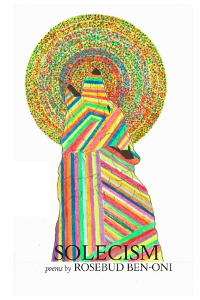 Solecism
Solecism
by Rosebud Ben-Oni
Virtual Artists Collective, 2013
80 pages / $15 Buy from Powell’s or Amazon
The phrase “identity poetics” has always struck me as strange. “Identity” comes from a Latin word that means most nearly “being the same,” and “poetics” from an Indo-Euro base for “one who collects, or assembles.” But “to be the same as one who assembles,” means every poet’s an identity poet, and from certain angles, dripping wax over thester scrolls in a dank hovel of some dentine tower, that’s probably true. But I’d wager most people interested enough in “identity” to consider it together with “poetics” consider the “id” (most literally just simply “it,” as in “id est”) in “identity,” and thus some other entity must assume that pesky pronoun. Hence, identity poetics qua the familiar orientations: sex, class, and the hyphenate ethnic camps (African-, Asian-, Latin-, et c.).
But when a poet’s got not just one, but two (or more), and wildly—let’s not say oppositional, but incommensurable—competing and/or complementary identities, the poetic stakes increase exponentially. So’s the case with Rosebud Ben-Oni (whose given name trumps any nom-de-plumes that arise to mind). Daughter of a Jewish father and a Mexican mother, Ben-Oni’s poems carry that heritage into the nonstandard impropriety of Solecism, a book of exodus and translation. These poems, rooted in autobiography, enact politics in ways that fail to strike one reluctant pedant as even remotely didactic.
Ben-Oni starts with the motherland and charts expanding circles with Israel, Mexico, and Manhattan at the respective center of each. The book’s scope expands to encompass the Middle East at large, all the borderlands’ length, and the greater metropolitan boroughs, winding up finally in Hong Kong (we’ll get there). Her course proves most interesting when these circles intersect, as with forgotten, historic Baghdad Beach of Matamoros, Mexico (which even seagulls, it seems, seek to flee) or Mt. Scopus, “an Israeli enclave in Arab East Jerusalem,” a territory likewise divided.
Ben-Oni’s poems don’t seek to bridge these divides or to reconcile a sympathetic speaker to this world defined by walls. Neither does she let the reader waffle in some non-space of dialectical nonsense. Instead, she collects words and phrases from across several languages and dialects to shape the collection’s texture, composed as much of Prospect Park and Flushing, Queens as it is tahini and achiote. Ben-Oni italicizes select words in Spanish (“colonia”), Hebrew (“dabar”), and Arabic (“wadi”), which she defines in footnotes, plus others in English, now chiefly North American (like “rawboned,” e.g.). The effect at first is like that old adage about Dick Branson tossing darts at a map: it may seem scattershot and haphazard, but the lexical globetrotting echoes always those sites I have to believe Ben-Oni’s speakers call home, strong as the drive for relocation may be.
July 26th, 2013 / 11:00 am
Detachment: On Shira Dentz’ door of thin skins
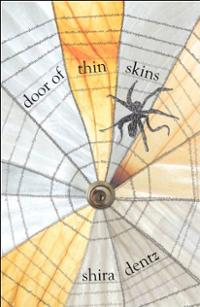 door of thin skins
door of thin skins
by Shira Dentz
CananKerry Press, 2013
96 pages / $16 Buy from Amazon
The retina is brain tissue that lines the inner surface of the eye, captures images of the visual world, and communicates them to the brain. Retinal detachment is a disorder in which the retina peels away from the eye. It is often caused by an injury or trauma to the eye or head that breaches the barrier. That breach that allows fluid to seep under the retina and to peel off the way wallpaper peels from a wall. Initially, the person might initially see clouds in their vision often called “floaters.” As detachment progresses, a moon-shaped shadow appears in the periphery of the visual field and starts to billow like a sail in the wind.
Shira Dentz’s door of thin skins narrates a fairy-tale-like story, “perhaps / a fairy tale,” of a young woman’s trials with her shapeshifting psychotherapist, Dr. Abe. Part lizard, part whale, part Macy’s Day balloon, Dr. Abe is a big man with narrow tongue, “but really it was such a narrow tongue.” Dr. Abe’s office is a veritable forest with its brambly hedges, placid buffalos, quick meadows, and spider plants. It is “fashioned according to Freud, lover of the primitive.” Trained at the White Institute along with Rollo May and under the tutelage of Eric Fromm, Dr. Abe also fashions his practice after one of the institute’s major influences, Sandór Ferenczi, the Hungarian psychoanalyst and contemporary of Freud.
Both Sandor Ferenczi and Otto Rank broke from Freud in the 1920’s to collaborate on the development of a different form of psychotherapy. Claiming that Freud’s requirement for emotional detachment on the part of the psychotherapist leads to “an unnatural elimination of all human factors in the analysis,” they endorsed a type of “here-and-now” approach that emphasized the clinical importance of attachment, intimacy, and intersubjectivity, encouraging more countertransference and mutuality between patient and doctor.
Ferenczi is also widely known for his “confusion of tongues” theory of trauma. In his essay on the topic, he explains that when children playfully communicate the desire to be the spouse of a parent, they are speaking with a infantile and tender tongue. “We find the hidden play of taking the place of the parent of the same sex in order to be married to the other parent, but it must be stressed that this is merely phantasy; in reality the children would not want to, in fact they cannot do without tenderness…” According to Ferenczi, the danger lies when the pathological adult misinterprets this call for tenderness as a call for passion.
In fact, in the 1920s, Freud broke from himself and repudiated his theory that female hysterics really suffered sexual abuse. According to Judith Herman, he did this because he could not cope with the truth that sexual abuse was pandemic and therefore repressed it. In my thinking, the same sort of repression may have occurred with Ferenczi in his “confusion of tongues theory,” for according to him, the confusion is still based on mutual dialogue, on the innocent participation on behalf of the child. Perhaps like Freud he couldn’t cope with the fact that many children do not participate in the conversation. They don’t call out for tenderness in some sort of spousal fantasy. Instead they cry angrily for safety while the “pathological” adult ignores these calls and forces the “pathological” tongue upon the child. Certainly this is true of Dentz’s child.
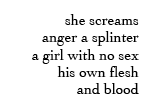
Here, Dentz speaks to the event in the third person. When she screams, when she articulates her infantile and angry tongue. Her voice is detached from first-person self, for the “I,” could no longer bear witness to real world but instead is left floating in a world of chaos.
July 26th, 2013 / 11:00 am
25 Points: VARIOUS SMALL BOOKS: Referencing Various Small Books by Ed Ruscha
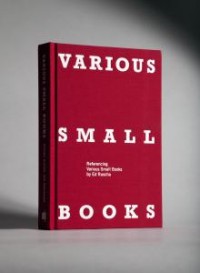 VARIOUS SMALL BOOKS: Referencing Various Small Books by Ed Ruscha
VARIOUS SMALL BOOKS: Referencing Various Small Books by Ed Ruscha
Edited and compiled by Jeff Brouws, Wendy Burton, and Herman Zschiegner
Text by Phil Taylor, with an essay by Mark Rawlinson
MIT Press, 2013
288 pages / $39.95 buy from MIT Press or Amazon
1) “An evil word it is this love.” – Amiri Baraka (LeRoi Jones)
Perhaps the closest I’ve ever come to an original Ed Ruscha was working at the Graduate Theological Union (GTU) Library over in Berkeley up on the hill next to the University of California in 2002 or so. There was an art exhibit lasting several months of “religious art” or maybe it was “ideas of evil in art”… which included Ruscha’s one-word painting “Evil” (blood stains on satin) in its ever terrifically seducing red.
2) Or it may have actually been earlier than that, in the basement room at poet Tom Clark’s house in Berkeley on break from Poetics classes waiting for the bathroom. If, that is, it’s true that the tall horizontal painting of a semi-masked figure (some kind of postmodern Lone Ranger?) on one wall is in fact a Ruscha self-portrait. Which I hazily recollect being told by somebody sometime later on—or is it that it was a portrait of Ruscha done by Tom?
3) Regardless, my real introduction to Ruscha came via Jeffrey Karl Butler formerly of Portland, Oregon. Jeff once sent me a chair through the mail. An Eames-inspired piece. He knocked off the feet attaching various caps from an assortment of common household items in their place. The chair was sitting in my apartment vestibule beside the mailboxes when I came home from working at the GTU one day. Without packing or anything, a USPS shipping label smacked onto the front of the seatback, “LEGS” stenciled atop the back of the seatback, and under the seat stenciled “JKB ’01”.
4) “Fifty years ago, in 1962, Edward Ruscha published Twentysix Gasoline Stations, the first of a series of photobooks the artist made through the 1960s and 1970s. Consisting of black and white photographs of twenty-six filling stations situated along Route 66 between Los Angeles and Oklahoma, this deceptively simple book, much like Marcel Duchamp’s Fountain (1917), irrevocably altered our understanding of art.”
– Mark Rawlinson
5) The gist of Various Small Books is to document every photobook “known as of May 31, 2012, with apologies for anything omitted” which one way or another continues, extends, or otherwise is in conversation with Ruscha.
6) A short text describing each photobook accompanies one or more photographs of the project. Many are also accompanied by a full two-page spread of images from out the photobook.
7) Photobooks are grouped in chronological order by year of publication: 1954-1987 (five projects), 1991-2000 (seven projects), 2002-2006 (twenty-two projects), 2007-2008 (nineteen projects), 2009 (fifteen projects), 2010 (seventeen projects), 2011 (five projects).
8) The first photobook presented is Ginza Kaiwai and Ginza Haccho by Shobachi Kimura and Yoshikazu Suzuki published in 1954. This boxed set of two volumes contains Ginza Kaiwai “an extensive history of the neighborhood of Ginza,” complete with photographs and maps, while “alongside this conventional book is a concertina volume, Ginza Haccho, with two parallel photographic panoramas of every building on the avenue Ginza 8-chrome between Shinbashi and Kurobashi bridges.” The impact of “a western influence” on this neighborhood is noticeable in the photographs and although it’s an open question whether Ruscha ever knew of “this remarkable predecessor” the possibilities are too enticing not to risk “anachronism or attributing influence where perhaps none existed.”
9) Ruscha’s Every Building on the Sunset Strip appeared thirteen years after Ginza Kaiwai and Ginza Haccho.
10) Some other photobooks likewise concerned with a specific strip of commercial or otherwise set of buildings: Robert Venturi, Denise Scott Brown, and Steven Izenour’s Learning from Las Vegas, Robbert Flick’s Parade Route, Jean-Frédidéric Schnyder’s Zugerstrasse Baarerstrasse, Jonathan Monk’s None of the Buildings on the Sunset Strip, Edgar Arceneaux’s 107th Street Watts, Stan Douglas’ Every Building on 100 West Hastings, and Keith Wilson’s Every Building on Burnet (burn-it) Road. READ MORE >
July 25th, 2013 / 3:04 pm
In case you missed it, this piece in the Boston Review today is causing quite a stir on the interwebs: Against Conceptualism: Defending the Poetry of Affect. Bringing it into this sphere. Curious to hear thoughts from readers?

